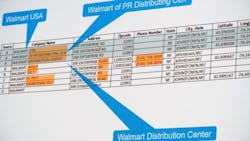Data, data, data and more data — it's coming from everywhere in today's business of trucking. Maybe it can be harnessed to tell you very useful things and give your fleet significant advantages. Except... maybe not.
At the TMW Systems-PeopleNet in.sight conference earlier this week, Mindy Curnutt, vice president of information management at TMW, explored that point in describing the company's work in data services and market intelligence.
What about all that data trucking companies are compiling? She likened it to a night sky unadulterated by city and street lights — a beautiful, virtually endless expanse that can leave the viewer feeling overwhelmed and tiny as a gnat. "It's mind-boggling. It's really hard to get your head around how much data we're talking about here," Curnutt said.
"Data is now constantly coming in from all different sources — dispatch, drivers, devices, sensors, GPS, phones, tablets, check-ins, emails, on and on," she noted. "Every week we've got some new device that's spewing it."
"Spewing" might be most accurate: fleets and trucking companies are generating and collecting all manner of data, but may not be doing much more than gathering clutter due to errors and confusion in the information.
More data doesn't mean good data
"This amount of data creates all new possibilities. It's really a beautiful thing," Curnutt told listeners. "Or is it? Maybe it's not a beautiful thing; maybe it's a rat's nest. Maybe it's a tangled ball of twine."
Curnutt used samples from a few TMW customer databases regarding a location she'd expected would be common: a Walmart distribution center. One database had the distribution center "with three different company IDs, three different names, two slightly different addresses and a lat-long that actually doesn't represent physically where the Walmart was," she said.
A second TMW customer had the location under different names, non-matching addresses and phone numbers and different — and no more accurate than the first customer's — latitude-longitude GPS coordinates.
Taking a larger "scoop" of customer data on this Walmart's location and entering the positions on an ALK Technologies map, Curnutt had to zoom out a ways to show all the red dots in perhaps a 10-mi. spread here, there and everywhere within that radius.
"This is a problem," Curnutt stressed. "How are we supposed to get industry-wide business intelligence and do things like trending and aggregates and averages and analyze behavior for things like average time off of ETA if we can't even agree on what this is called and where it is for something as big as a Walmart distribution center?"
Consider, now, data for much smaller, less-frequented locations, and the information your drivers may be getting on their way to deliveries.
The fix — and a changed world
"The good news is that there's a way to resolve all this," Curnutt told the audience, and that is to "create a master list of defined things" or reference data set. "We want to define things like location and turn this messy blob or rat's nest or lump of coal into a gem, into a diamond," she added.
The goal is to generate industry-wide analytics and market intelligence from the mass of data commotion. She referenced the launch in July of Niantic's Pokemon GO, the augmented reality game that lets users track down and interact with fictional, animated Pokemon creatures on a smartphone or other camera-equipped mobile device.
"How do you think Pokemon GO went from nothing to having more users than Facebook, LinkedIn and Twitter in two weeks and didn't go down? You think they did that with their own data center? I don't think so," Curnutt contended. "You call Amazon and say, 'I need more power,' and they give it to you just like that."
"The world has changed," she continued. "This is now possible with recent things like scale computing, machine learning, the concept of having a data scientist on staff and scaling up."
For trucking, the idea is to create a reference data "de-duping and mapping engine," she said, that wouldn't have to do anything to customers' individual databases. Regardless of what a given customer entered in name, location and so on for something like the Walmart distribution center in her example, this conceptual master data engine could recognize what the correct entries should be.
"And there can be more benefits," Curnutt added. "What if when you were onboarding a new location you'd never delivered to and started entering it, the application said, 'Do you mean this,' and if you said yes, it just populated the rest of the data and you didn't have to type anything?"
As a future-looking possibility, she described how such a master data engine could provide actionable business intelligence — things like optimizing a delivery to a new customer for least possible dwell time.
"You've never delivered there before, you enter it as a new location and something like this could pop up," Curnutt described the concept, showing a mock-up dwell time comparison chart. "You'd be able to know, if you were going to be delivering here on a Saturday between 3:00 and 5:00 p.m., that the average dwell time there is 70 minutes.
"Maybe if I came in between 2:00 and 5:00 a.m., the dwell time is 10 minutes," she said. "That'd be an hour savings, and you'd instantly know that without having to have had years of understanding and working with this location."
That's the kind of industry intelligence and functionality TMW is working on, according to Curnutt. "You'd spend less time entering data; you'd have more accurate data; you'd have immediate access to powerful, industry-wide analytics; you could make better, well-informed decisions," she said. "So keep that in your thoughts on TMW and the Big Data opportunity before us."
About the Author
Aaron Marsh
Aaron Marsh is a former senior editor of FleetOwner, who wrote for the publication from 2015 to 2019.


